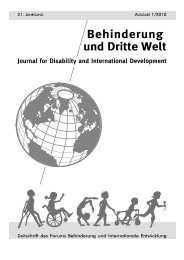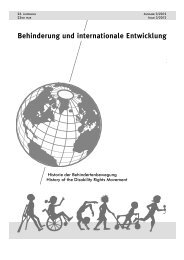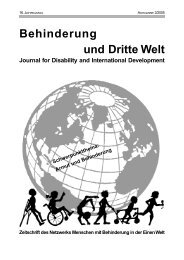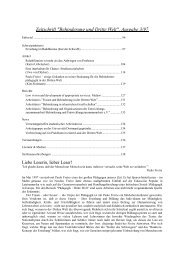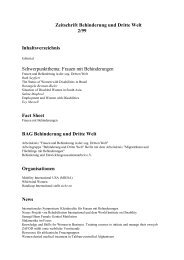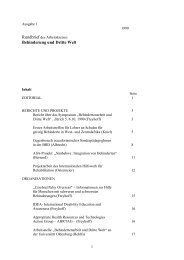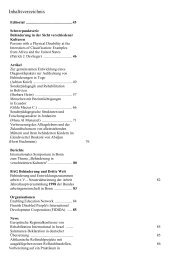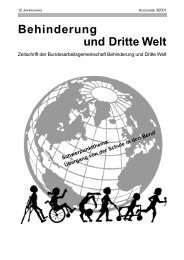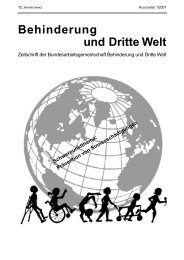Zeitschrift Behinderung und Dritte Welt
Zeitschrift Behinderung und Dritte Welt
Zeitschrift Behinderung und Dritte Welt
You also want an ePaper? Increase the reach of your titles
YUMPU automatically turns print PDFs into web optimized ePapers that Google loves.
S CHWERPUNKTTHEMAThe example of the Midwifery Committee’sconsciousness of disability issues attests to theneed for disabled women’s perspectives in thestruggle to reclaim women’s control from themale industry of obstetrics and the medicalizationof female bodies (Lloyd: 1992). Gender equityand women’s self-determination cannot berealized without politicizing the exclusion ofwomen with disabilities from gender concerns.Our reproductive choices, as disabledwomen, are also constrained by the law. Wecannot presume that our civil and human rightswill be protected. In the early and middle periodsof the 20th century in Canada the compulsory(non-consensual) sterilization of womenwith disabilities was commonplace and legallysanctioned in some provinces. This will be discussedfurther in the context of eugenics.Today HIV positive women in Namibia arebeing sterilized against their will. The sexualrights of women with disabilities are also beingcurtailed in the recently emerging issue of thecriminalization of HIV transmission. 6 On aregular basis, women with disabilities experienceoppression as a ‘minority within a minority’and often the first site of this subjugation isoppression of sexuality: constraint of sexualrights and the denial of freedom to makechoices about ones sexuality. In emerging discussionsand cases arising from the criminalizationof HIV transmission we are beginning tosee the ways in which women will be the firstones to suffer from these new laws.Disabled women’s experience illuminates theableism inherent in gender oppression andconsequently facilitates pathways towards justiceby revealing hidden biases against thenatural occurrence of the human diversity welabel as disabled. This is not to deny that somedisabling conditions are a source of pain and/or suffering. The point is that disability is part ofthe human condition and its occurrence doesnot naturally diminish one’s humanity. Culturallabels of defect are what rob people of theirdignity and rights. Confronting disabledwomen’s issues as integral to feminist endeavorsenriches society. “We need an <strong>und</strong>erstandingof disability that does not support a paradigmof humanity as young and healthy. Encouragingeveryone to acknowledge, accommodate,and identify with a wide range ofphysical conditions is ultimately the road toself-acceptance as well as the road to liberatingthose who are disabled now” (Wendell: 108).Currently, feminist discourse indicates a shiftto inclusion of disabled women’s voices. A Koreandisability rights activist spoke at the openingplenary of the 2008 Forum of the Associationof Women’s Rights in Development-perhapsthe foremost international feminist gatheringin the world. The conference program includedfive sessions specifically dedicated to theconcerns of disabled women. This is a recordnumber of disability-specific sessions at an internationalconference not specifically focusedon disability issues. We, individually and collectively,need to make a conscious effort to dismantlethe naturalized stereotypes of disabilityand specifically the myth of disabled women’sasexuality in order to effect meaningful socialchange. Otherwise we face the risk of reinforcingprejudice through tokenism or patronizingcharitableness.Eugenics and its Role in DisabledWomen’s OppressionIn Canada, the institutionalization of disabledwomen’s oppression emerges from the brief butformative reign of eugenics, the so-called scienceof selective human breeding and socialimprovement. The Canadian suffragists whowere at the forefront of women’s emancipationin the early 20th century were avid eugenicistswho degraded women and men with disabilitiesin order to further their feminist project. Bydelineating disability as the marker of true humaninferiority, first wave feminists assertedtheir equality with the elite males who comprisedCanadian structures of power.These women’s rights activists played an instrumentalrole in constructing the differencethey targeted in other women as abnormal,subnormal, and separate from themselves. Wehave to confront this history if we hope to everlive in harmony with diversity. Prominent Canadiannation builders such as Emily Murphy andNellie McClung deliberately worked to shift culturalimages of incompetence and weaknessaway from females to people whom they identifiedas defective. Thus perceived physical orcognitive impairment, non-British ethnicity,criminality, prostitution, and poverty were constitutedas a feeblemindedness that threatenedthe fabric of Canadian society. Eugenicists advocatedfor the identification, segregation, andcontrol of defectives through sexual sterilization.Although eugenics fell out of fashion afterknowledge of its implementation in Nazi exterminationcamps surfaced 7 scholars such asDaniela Stehlik argue that eugenic practicescontinue, only now they are surro<strong>und</strong>ed bywhat she calls the updated “corporate/neoeugenicdiscourses” (2001: 374) of genetic engineering,prenatal testing, abortion, andeuthanasia. These discourses sanction violence18 <strong>Zeitschrift</strong> <strong>Behinderung</strong> <strong>und</strong> <strong>Dritte</strong> <strong>Welt</strong> 3/2009



